Cause Analysis of Unsafe Behaviors in Hazardous Chemical Accidents: Combined with HFACs and Bayesian Network
Abstract
:1. Introduction
2. Materials and Methods
2.1. Revised HFACs for HCAs
2.2. Bayesian Network (BN)
2.3. BN-HFACs and Failure Sensitivity
2.3.1. BN-HFACs
2.3.2. Failure Sensitivity
2.4. Data Collection and Coding Process
2.4.1. Data Collection
2.4.2. Coding Process
3. Results
3.1. Transform HFACs into the Topology of BN
3.2. Probability Matrix of BN-HFACs
3.3. Failure Sensitivity Analysis of BN-HFACs
4. Discussion
4.1. Theoretical Implication
4.2. Practical Implication
4.3. Limitations and Future Research Directions
5. Conclusions
Author Contributions
Funding
Conflicts of Interest
References
- Ren, J.; Mu, Y. Statistical analysis and management enlightenment of hazardous chemicals accidents. Chem. Enterp. Manag. 2015, 16, 28–31. [Google Scholar]
- Zhao, L.; Qian, Y.; Hu, Q.; Jiang, R.; Li, M.; Wang, X. An analysis of hazardous chemical accidents in China between 2006 and 2017. Sustainability 2018, 10, 2935. [Google Scholar] [CrossRef] [Green Version]
- Wu, Z.; Zhang, S.; Zhang, Y.; Shi, C.; Liu, N.; Yang, G.L. Statistical analysis of hazardous chemicals accidents occurring in China during 2006–2010. J. Saf. Sci. Technol. 2011, 7, 5–9. [Google Scholar]
- Li, J.; Bai, X.; Ren, Z.; Wu, J. Statistic analysis and countermeasures of hazardous chemicals accidents occurring in China during 2011–2013. J. Saf. Sci. Technol. 2014, 10, 142–147. [Google Scholar]
- Wang, Y.; Wang, Y.; Zhao, X. Characteristics of typical hazardous chemical accidents in China in 2016 and discussion on countermeasures. Occup. Health Emerg. Rescue 2017, 35, 323–327. [Google Scholar]
- Fu, G.; Xie, X.; Jia, Q.; Li, Z.; Chen, P.; Ge, Y. The development history of accident causation models in the past 100 years: 24Model, a more modern accident causation model. Process. Saf. Environ. Prot. 2019, in press. [Google Scholar] [CrossRef]
- Reason, J.T. Human Error; Cambridge University Press: New York, NY, USA, 1990. [Google Scholar]
- Shappell, S.A.; Wiegmann, D.A. The human factors analysis and classification system-HFACS. Security 2000. Available online: https://commons.erau.edu/publication/737 (accessed on 16 February 2018).
- Chen, P.; Mou, J.; Van Gelder, P.H.A.J.M. Integration of individual encounter information into causation probability modelling of ship collision accidents. Saf. Sci. 2019, 120, 636–651. [Google Scholar] [CrossRef]
- Zhang, Y.; Jing, L.; Sun, C.; Fang, J.; Feng, Y. Human factors related to major road traffic accidents in China. Traffic Inj. Prev. 2019, in press. [Google Scholar] [CrossRef]
- Celik, M.; Cebi, S. Analytical HFACS for investigating human errors in shipping accidents. Accid. Anal. Prev. 2009, 41, 66–75. [Google Scholar] [CrossRef]
- Chen, S.; Wall, A.; Davies, P.; Yang, Z.; Wang, J.; Chou, Y.H. A human and organisational factors (HOFs) analysis method for marine casualties using HFACS-Maritime Accidents (HFACS-MA). Saf. Sci. 2013, 60, 105–114. [Google Scholar] [CrossRef]
- Akyuz, E. A marine accident analyzing model to evaluate potential operational causes in cargo ships. Saf. Sci. 2017, 92, 17–25. [Google Scholar] [CrossRef]
- Chen, Z.; Qiao, G.; Zeng, J. Study on the Relationship between Worker States and Unsafe Behaviours in Coal Mine Accidents Based on a Bayesian Networks Model. Sustainability 2019, 11, 5021. [Google Scholar] [CrossRef] [Green Version]
- Lenné, M.G.; Salmon, P.M.; Liu, C.C.; Trotter, M. A systems approach to accident causation in mining: An application of the HFACS method. Accid. Anal. Prev. 2012, 48, 111–117. [Google Scholar] [CrossRef] [PubMed]
- Patterson, J.M.; Shappell, S.A. Operator error and system deficiencies: Analysis of 508 mining incidents and accidents from Queensland, Australia using HFACS. Accid. Anal. Prev. 2010, 42, 1379–1385. [Google Scholar] [CrossRef]
- Daramola, A.Y. An investigation of air accidents in Nigeria using the Human Factors Analysis and Classification System (HFACS) framework. J. Air Transp. Manag. 2014, 35, 39–50. [Google Scholar] [CrossRef]
- Gong, L.; Zhang, S.; Tang, P.; Lu, Y. An integrated graphic-taxonomic-associative approach to analyze human factors in aviation accidents. Chin. J. Aeronaut. 2014, 27, 226–240. [Google Scholar] [CrossRef] [Green Version]
- Al-Wardi, Y. Arabian, Asian, western: A cross-cultural comparison of aircraft accidents from human factor perspectives. Int. J. Occup. Saf. Ergon. 2017, 23, 366–373. [Google Scholar] [CrossRef]
- Zhan, Q.; Zheng, W.; Zhao, B. A hybrid human and organizational analysis method for railway accidents based on HFACS-Railway Accidents (HFACS-RAs). Saf. Sci. 2017, 91, 232–250. [Google Scholar] [CrossRef]
- Zhou, J.; Lei, Y. Paths between latent and active errors: Analysis of 407 railway accidents/incidents’ causes in China. Saf. Sci. 2018, 110, 47–58. [Google Scholar] [CrossRef]
- Zhang, Y.; Liu, T.; Bai, Q.; Shao, W.; Wang, Q. New systems-based method to conduct analysis of road traffic accidents. Transp. Res. Part F Traffic Psychol. Behav. 2018, 54, 96–109. [Google Scholar] [CrossRef]
- Hale, A.; Walker, D.; Walters, N.; Bolt, H. Developing the understanding of underlying causes of construction fatal accidents. Saf. Sci. 2012, 50, 2020–2027. [Google Scholar] [CrossRef]
- Sun, K.; Li, Q.; Xu, X.; Yin, Z. Risk analysis on human factors in operation of high risk construction based on dynamic Bayesian network. J. Hydroelectr. Eng. 2017, 36, 28–35. [Google Scholar]
- Hulme, A.; Stanton, N.A.; Walker, G.H.; Waterson, P.; Salmon, P.M. What do applications of systems thinking accident analysis methods tell us about accident causation? A systematic review of applications between 1990 and 2018. Saf. Sci. 2019, 117, 164–183. [Google Scholar] [CrossRef]
- Kim, S.K.; Lee, Y.H.; Jang, T.I.; Oh, Y.J.; Shin, K.H. An investigation on unintended reactor trip events in terms of human error hazards of Korean nuclear power plants. Ann. Nucl. Energy 2014, 65, 223–231. [Google Scholar] [CrossRef]
- Yoona, Y.S.; Hamb, D.H.; Yoonc, W.C. A New Approach to Analysing Human-Related Accidents by Combined Use of HFACS and Activity Theory-Based Method. Cogn. Technol. Work. 2017, 19, 759–783. [Google Scholar] [CrossRef]
- Theophilus, S.C.; Esenowo, V.N.; Arewa, A.O.; Ifelebuegu, A.O.; Nnadi, E.O.; Mbanaso, F.U. Human factors analysis and classification system for the oil and gas industry (HFACS-OGI). Reliab. Eng. Syst. Saf. 2017, 167, 168–176. [Google Scholar] [CrossRef]
- Zhou, L.; Fu, G.; Xue, Y. Human and organizational factors in Chinese hazardous chemical accidents: A case study of ‘8.12’ Tianjin Port fire and explosion using the HFACS-HC. Int. J. Occup. Saf. Ergon. 2017, 24, 329–340. [Google Scholar] [CrossRef]
- Zhang, Y.; Jing, L.; Sun, C. Systems-Based Analysis of China-Tianjin port fire and explosion: A comparison of HFACS, AcciMap, and STAMP. J. Fail. Anal. Prev. 2018, 18, 1386–1400. [Google Scholar] [CrossRef]
- Jiang, W.; Han, W. Analysis of “2·28” KEEPER Chemical Industries Hazardous Chemical Explosion Accident Based on FTA and HFACS. Int. J. Environ. Res. Public Health 2018, 15, 2151. [Google Scholar] [CrossRef] [Green Version]
- Wang, Y.F.; Xie, M.; Chin, K.S. Accident analysis model based on Bayesian Network and Evidential Reasoning approach. J. Loss Prev. Process. Ind. 2013, 26, 10–21. [Google Scholar] [CrossRef]
- Mirzaei, M.A.; Aghaei, H.; Kalatpour, O.; Soltanian, A.R.; Nikravesh, A. Analysis of human and organizational factors that influence mining accidents based on Bayesian network. Int. J. Occup. Saf. Ergon. 2018, in press. [Google Scholar] [CrossRef]
- Xia, N.; Zou, P.X.W.; Liu, X.; Wang, X.; Zhu, R. A hybrid BN-HFACS model for predicting safety performance in construction projects. Saf. Sci. 2018, 101, 332–343. [Google Scholar] [CrossRef]
- Wang, Y.F.; Faghih, R.S.; Hu, X.M.; Xie, M. Investigations of human and organizational factors in hazardous vapor accidents. J. Hazard. Mater. 2011, 191, 69–82. [Google Scholar] [CrossRef] [PubMed]
- Pearl, J. Bayesian networks: A model of self-activated memory for evidential reasoning. In Proceedings of the 7th Conference of the Cognitive Science Society, University of California, Irvine, CA, USA, 15–17 August 1985; pp. 329–334. [Google Scholar]
- Lyu, T.; Song, W.; Du, K. Human Factors Analysis of Air Traffic Safety Based on HFACS-BN Model. Appl. Sci. 2019, 9, 5049. [Google Scholar] [CrossRef] [Green Version]
- Yin, X. Elements importance and sensitivity analysis based on Bayesian network. J. Shenyang Inst. Eng. (Nat. Sci.) 2012, 8, 262–265. [Google Scholar]
- Website of China Chemical Safety Association. Available online: http://www.chemicalsafety.org.cn/ (accessed on 1 March 2019).
- Madigan, R.; Golightly, D.; Madders, R. Application of Human Factors Analysis and Classification System (HFACS) to UK rail safety-of-the-line incidents. Accid. Anal. Prev. 2016, 97, 122–131. [Google Scholar] [CrossRef] [Green Version]
- Liu, R.; Cheng, W.; Yu, Y.; Xu, Q.; Jiang, A.; Lv, T. An impacting factors analysis of miners’ unsafe acts based on HFACS-CM and SEM. Process. Saf. Environ. Prot. 2019, 122, 221–231. [Google Scholar] [CrossRef]
- Huang, L.; Wu, C.; Wang, B.; Ouyang, Q.; Lin, H. An unsafe behaviour formation mechanism based on risk perception. Hum. Factors Ergon. Manuf. Ser. Ind. 2019, 29, 109–117. [Google Scholar] [CrossRef]
- Mirzaei, M.A.; Aghaei, H.; Kalatpour, O.; Soltanian, A.R.; SeyedTabib, M. Effects of human and organizational deficiencies on workers’safety behavior in a mining site in Iran. Epidemiol. Health 2018, 40, e2018019. [Google Scholar] [CrossRef]
- Fiedlander, M.A.; Evans, S.A. Influence of organizational culture on human error. In Proceedings of the 1997 IEEE Sixth Conference on Human Factors and Power Plants: Global Perspectives of Human Factors in Power Generation, Orlando, FL, USA, 8–13 June 1997; Volume 6, pp. 65–77. [Google Scholar]
- Liu, R.; Cheng, W.; Yu, Y.; Xu, Q. Human factors analysis of major coal mine accidents in China based on the HFACS-CM model and AHP method. Int. J. Ind. Ergon. 2018, 68, 270–279. [Google Scholar] [CrossRef]
- Fogarty, G.J.; Shaw, A. Safety climate and the theory of planned behavior: Towards the prediction of unsafe behavior. Accid. Anal. Prev. 2010, 42, 1455–1459. [Google Scholar] [CrossRef] [PubMed] [Green Version]
- Guo, B.H.W.; Yiu, T.W.; González, V.A. Predicting safety behavior in the construction industry: Development and test of an integrative model. Saf. Sci. 2016, 84, 1–11. [Google Scholar] [CrossRef]
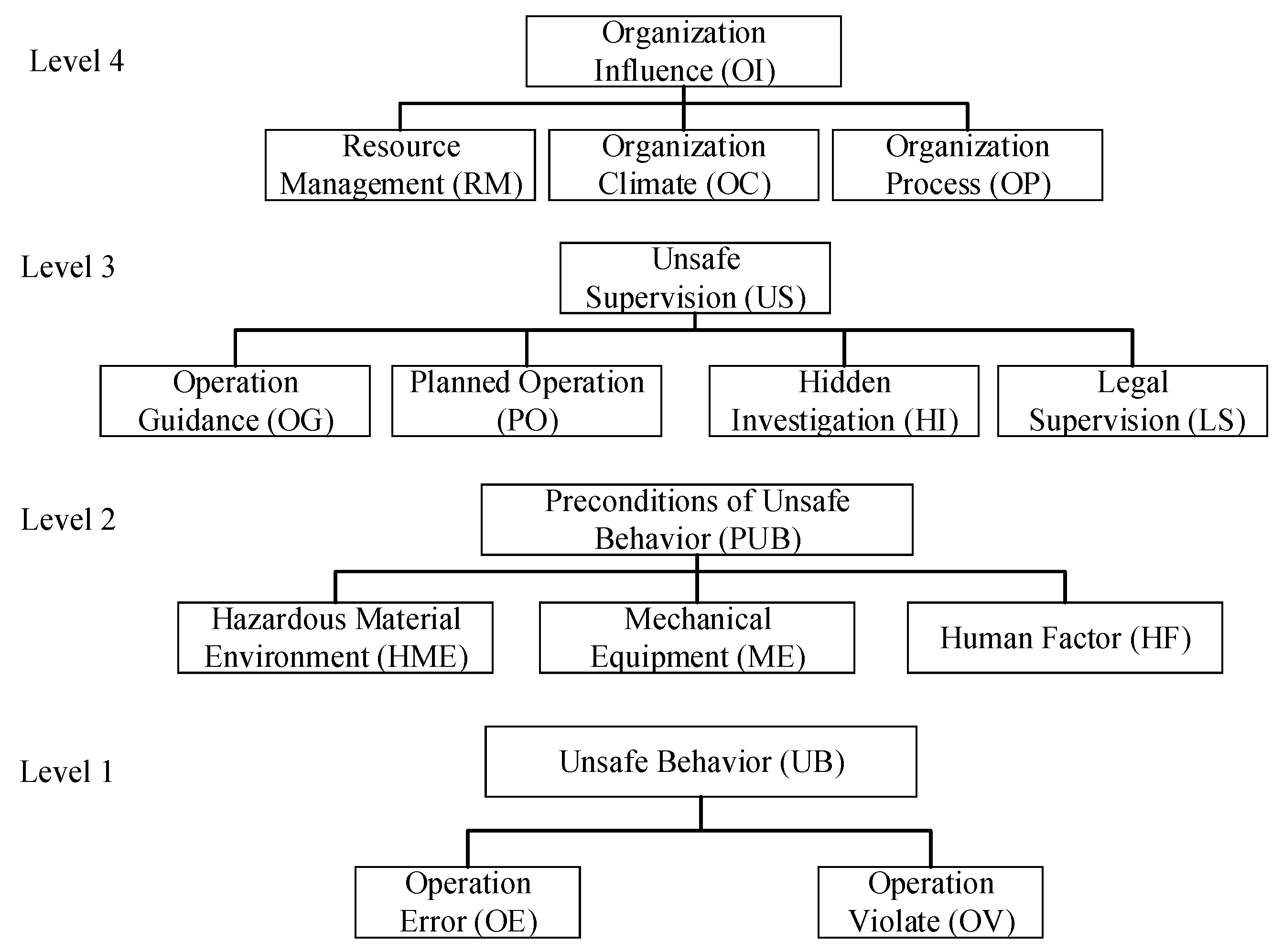
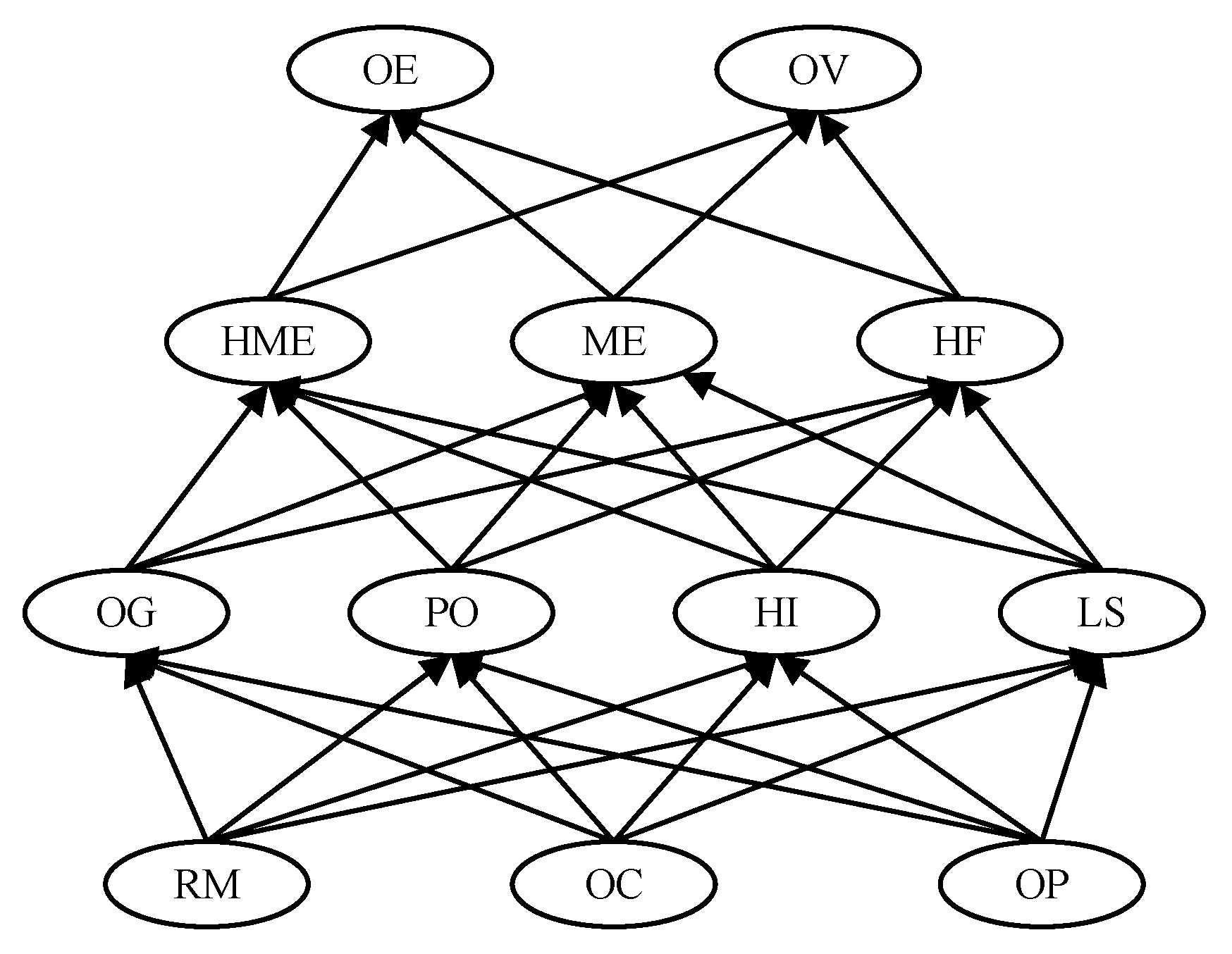
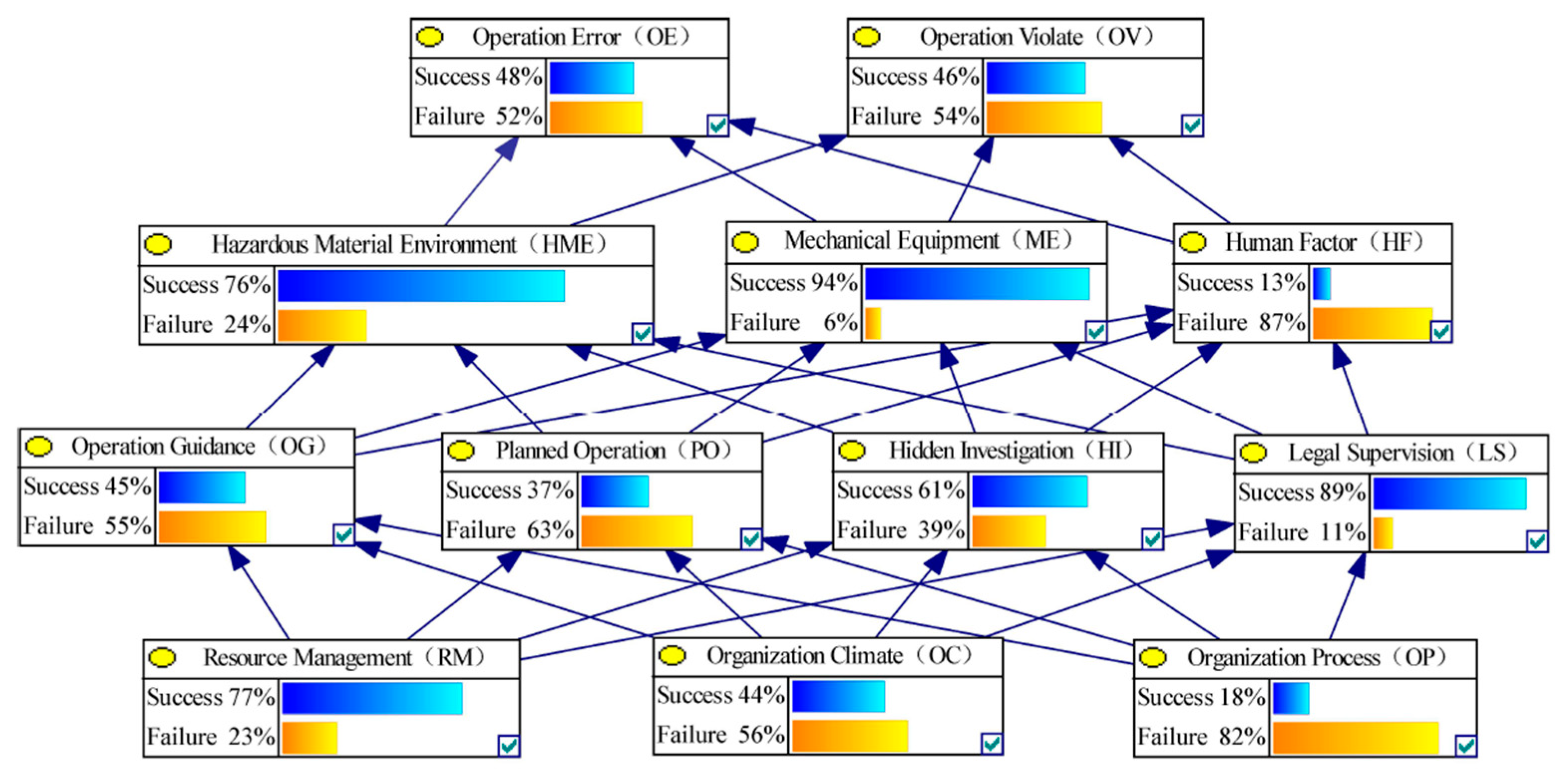
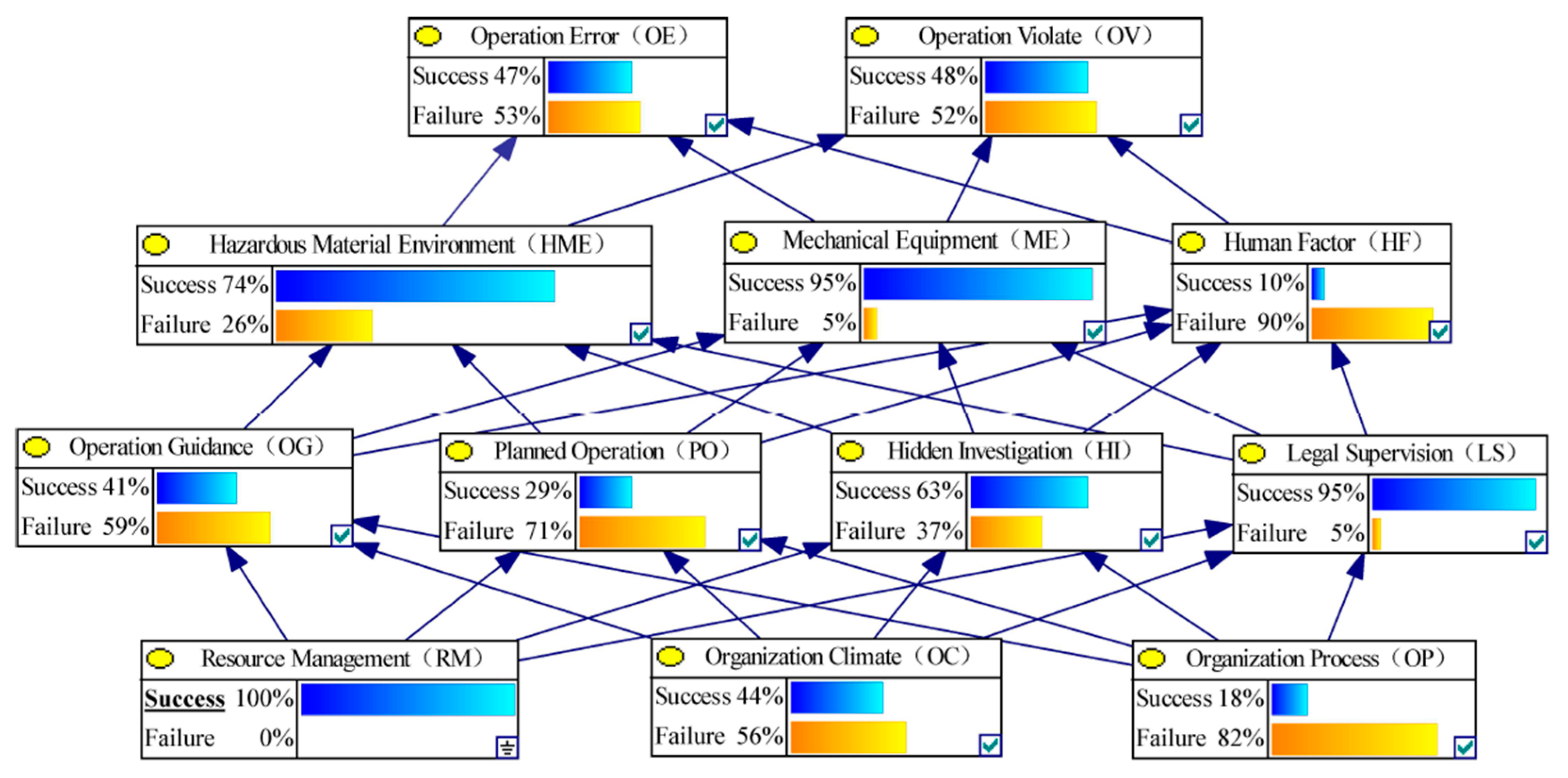
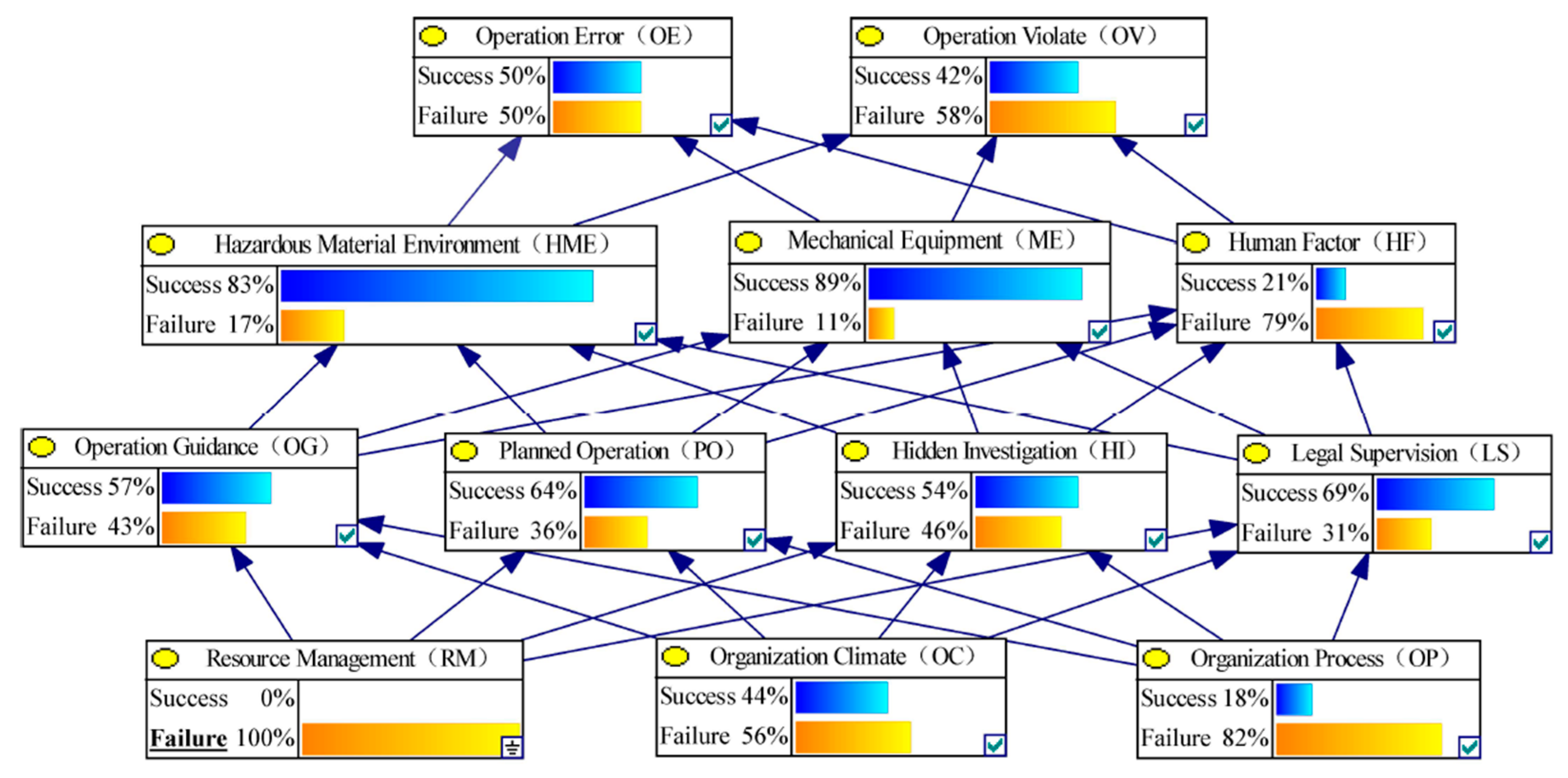
| Level | Subdivision Index | Explanation of Subdivision Index |
|---|---|---|
| UB | OE | OE refers to the operator’s unintentional wrong behavior |
| OV | OV refers to the operator’s non-compliance with the established plant regulations | |
| PUB | HME | HME means environmental factors related to hazardous chemicals, and there are three kinds of environmental factors including chemical gas leakage, chemical reactions, and meteorological conditions |
| ME | ME refers to the safety state of equipment with the functions of production and storage | |
| HF | HF includes risk identification ability, safety awareness, safety skills, and mutual rescue consciousness | |
| US | OG | OG includes three aspects, they are safety instruction from managers to operators, the supervision of managers about confined space, the supervision of managers to urge the operators to comply with the regulations |
| PO | PO mainly involves the operability of the operating procedures | |
| HI | HI includes two aspects, one is the risk perception of managers, and the other is that the managers do not eliminate the known hidden dangers timely | |
| LS | LS divides two facets, including operating tickets’ management conforms to regulation and managers obey the rules and regulations | |
| OI | RM | RM mainly refers to the input of safety production |
| OC | OC includes three aspects, they are enterprise safety responsibility, enterprise awareness of production safety, enterprise rules, and regulations about safety | |
| OP | OP includes safety management, safety education and training, emergency management, third-party evaluation, and so on |
| Nodes Status | RM-S | RM-F | ||||||
| OC-S | OC-F | OC-S | OC-F | |||||
| OP-S | OP-F | OP-S | OP-F | OP-S * | OP-F | OP-S | OP-F | |
| OG-S | 0.67 | 0.70 | 1.00 | 0.50 | 0.00 | 1.00 | 0.00 | 0.50 |
| OG-F | 0.33 | 0.30 | 0.00 | 0.50 | 1.00 | 0.00 | 1.00 | 0.50 |
| PO-S | 0.67 | 1.00 | 0.67 | 0.71 | 0.00 | 0.75 | 0.00 | 0.50 |
| PO-F | 0.33 | 0.00 | 0.33 | 0.29 | 1.00 | 0.25 | 1.00 | 0.50 |
| HI-S | 0.67 | 0.50 | 0.67 | 0.71 | 0.50 | 0.75 | 0.00 | 0.50 |
| HI-F | 0.33 | 0.50 | 0.33 | 0.29 | 0.50 | 0.25 | 1.00 | 0.50 |
| LS-S | 1.00 | 0.90 | 1.00 | 0.86 | 0.50 | 0.75 | 1.00 | 0.50 |
| LS-F | 0.00 | 0.10 | 0.00 | 0.14 | 0.50 | 0.25 | 0.00 | 0.50 |
| Nodes Status | OG-S | |||||||
|---|---|---|---|---|---|---|---|---|
| PO-S | PO-F | |||||||
| HI-S | HI-F | HI-S | HI-F | |||||
| LS-S | LS-F * | LS-S | LS-F | LS-S | LS-F | LS-S | LS-F | |
| HME-S | 0.93 | 0.50 | 0.67 | 1.00 | 1.00 | 1.00 | 1.00 | 1.00 |
| HME-F | 0.07 | 0.50 | 0.33 | 0.00 | 0.00 | 0.00 | 0.00 | 0.00 |
| ME-S | 0.86 | 0.67 | 1.00 | 0.67 | 1.00 | 1.00 | 1.00 | 1.00 |
| ME-F | 0.14 | 0.33 | 0.00 | 0.33 | 0.00 | 0.00 | 0.00 | 0.00 |
| HF-S | 0.36 | 0.00 | 0.00 | 0.67 | 0.00 | 0.00 | 0.50 | 0.00 |
| HF-F | 0.64 | 1.00 | 1.00 | 0.33 | 1.00 | 1.00 | 0.50 | 1.00 |
| Nodes Status | OG-F | |||||||
| PO-S | PO-F | |||||||
| HI-S | HI-F | HI-S | HI-F | |||||
| LS-S | LS-F * | LS-S | LS-F | LS-S | LS-F * | LS-S | LS-F * | |
| HME-S | 1.00 | 0.50 | 0.50 | 1.00 | 1.00 | 0.50 | 0.67 | 0.50 |
| HME-F | 0.00 | 0.50 | 0.50 | 0.00 | 0.00 | 0.50 | 0.33 | 0.50 |
| ME-S | 0.83 | 0.67 | 1.00 | 1.00 | 1.00 | 0.67 | 1.00 | 0.67 |
| ME-F | 0.17 | 0.33 | 0.00 | 0.00 | 0.00 | 0.33 | 0.00 | 0.33 |
| HF-S | 0.33 | 0.00 | 0.50 | 0.00 | 0.00 | 0.00 | 0.67 | 0.00 |
| HF-F | 0.67 | 1.00 | 0.50 | 1.00 | 1.00 | 1.00 | 0.33 | 1.00 |
| Nodes Status | HME-S | HME-F | ||||||
|---|---|---|---|---|---|---|---|---|
| ME-S | ME-F | HME-S | HME-F | |||||
| HF-S | HF-F | HF-S * | HF-F | HF-S | HF-F | HF-S | HF-F | |
| OE-S | 0.50 | 0.68 | 0.00 | 0.33 | 0.00 | 0.00 | 1.00 | 0.00 * |
| OE-F | 0.50 | 0.32 | 1.00 | 0.67 | 1.00 | 1.00 | 0.00 | 1.00 * |
| OV-S | 0.40 | 0.27 | 0.00 | 0.67 | 1.00 | 1.00 | 0.00 | 0.00 * |
| OV-F | 0.60 | 0.73 | 1.00 | 0.33 | 0.00 | 0.00 | 1.00 | 1.00 * |
| RM | OC | OP | OG | PO | HI | LS | HME | ME | HF | |
|---|---|---|---|---|---|---|---|---|---|---|
| OG | 0.00 | 4.73 | 0.00 | — | — | — | — | — | — | — |
| PO | 0.00 | 1.81 | 0.10 | — | — | — | — | — | — | — |
| HI | 0.24 | 0.00 | 0.00 | — | — | — | — | — | — | — |
| LS | 5.20 | 4.67 | 0.00 | — | — | — | — | — | — | — |
| HME | 0.00 | 4.29 | 0.39 | 6.60 | 3.71 | 0.00 | 0.00 | — | — | — |
| ME | 1.20 | 0.00 | 0.00 | 0.00 | 0.00 | 1.25 | 2.4 | — | — | — |
| HF | 0.00 | 0.25 | 0.01 | 0.22 | 0.21 | 0.00 | 0.03 | — | — | — |
| OE | 0.00 | 0.34 | 0.08 | 0.37 | 0.22 | 0.00 | 0.19 | 1.63 | 0.49 | 0.00 |
| OV | 0.12 | 0.00 | 0.00 | 0.00 | 0.00 | 0.18 | 0.13 | 0.00 | 0.00 | 0.00 |
© 2019 by the authors. Licensee MDPI, Basel, Switzerland. This article is an open access article distributed under the terms and conditions of the Creative Commons Attribution (CC BY) license (http://creativecommons.org/licenses/by/4.0/).
Share and Cite
Li, X.; Liu, T.; Liu, Y. Cause Analysis of Unsafe Behaviors in Hazardous Chemical Accidents: Combined with HFACs and Bayesian Network. Int. J. Environ. Res. Public Health 2020, 17, 11. https://doi.org/10.3390/ijerph17010011
Li X, Liu T, Liu Y. Cause Analysis of Unsafe Behaviors in Hazardous Chemical Accidents: Combined with HFACs and Bayesian Network. International Journal of Environmental Research and Public Health. 2020; 17(1):11. https://doi.org/10.3390/ijerph17010011
Chicago/Turabian StyleLi, Xiaowei, Tiezhong Liu, and Yongkui Liu. 2020. "Cause Analysis of Unsafe Behaviors in Hazardous Chemical Accidents: Combined with HFACs and Bayesian Network" International Journal of Environmental Research and Public Health 17, no. 1: 11. https://doi.org/10.3390/ijerph17010011
APA StyleLi, X., Liu, T., & Liu, Y. (2020). Cause Analysis of Unsafe Behaviors in Hazardous Chemical Accidents: Combined with HFACs and Bayesian Network. International Journal of Environmental Research and Public Health, 17(1), 11. https://doi.org/10.3390/ijerph17010011





